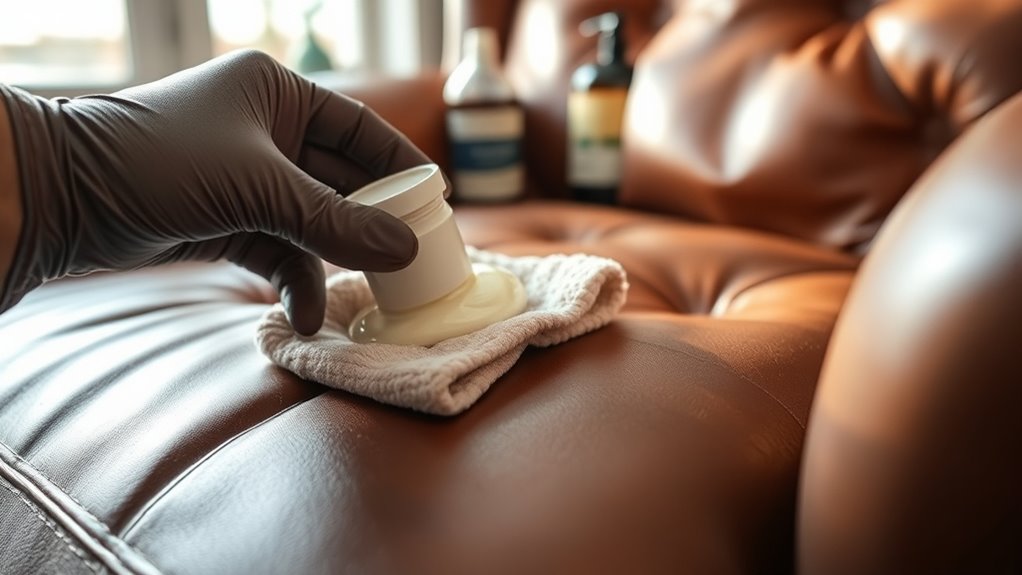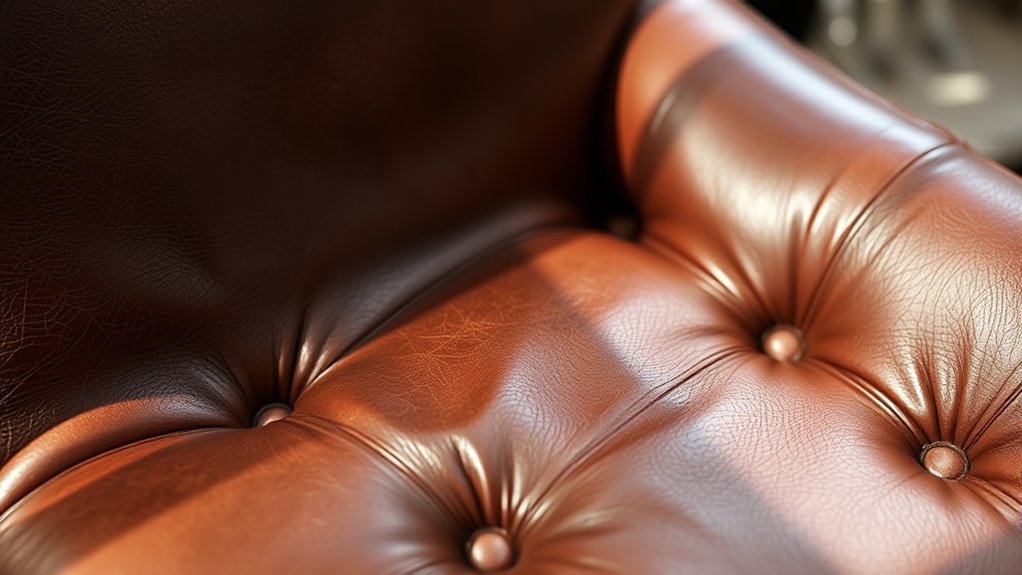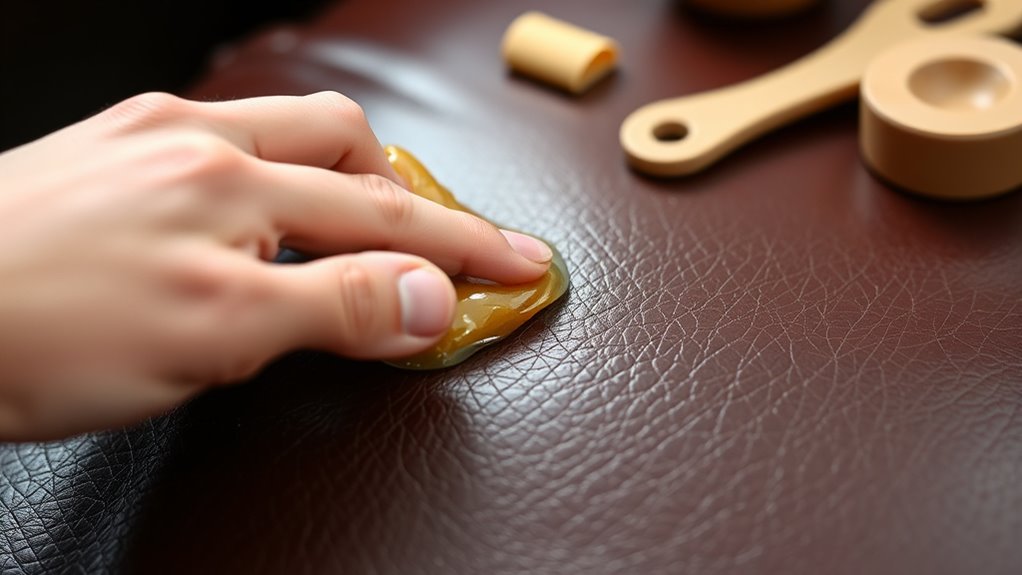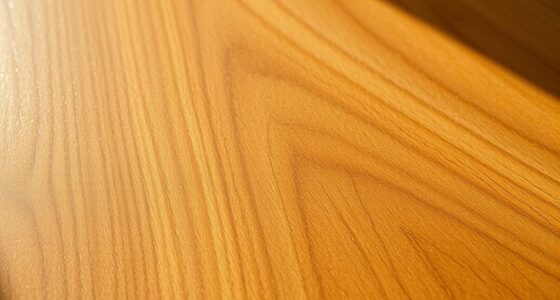Many myths about leather conditioning can actually harm your leather rather than help it. Overconditioning can weaken or crack the material, and not all conditioners are safe—some cause discoloration or damage. Frequent application isn’t necessary unless your leather is exposed to harsh conditions. Water-based products aren’t always safer, and not every product suits leather’s needs. Proper care involves using the right products and understanding their limits—continue exploring to learn how to protect your leather properly.
Key Takeaways
- Not all leather conditioners are safe; choose products specifically designed for leather to avoid damage.
- Overconditioning can cause leather to become too soft, crack, or lose its natural breathability.
- Water-based conditioners are not inherently safer; proper selection and application are essential.
- Conditioning cannot repair deep cracks or damage; professional restoration may be necessary.
- Regular, appropriate conditioning maintains leather’s appearance and durability, but excessive use can accelerate deterioration.
Overconditioning Can Damage Leather

While conditioning leather can keep it supple and protected, overdoing it can cause more harm than good. Applying too much conditioner disrupts the moisture balance, making the leather overly saturated. This excess moisture can lead to surface buildup, which attracts dirt and debris, dulling its appearance. Overconditioning also risks softening the leather too much, reducing its structural integrity and making it prone to stretching or cracking over time. It’s tempting to give leather frequent treatments to maintain its look, but too much conditioner can trap moisture and hinder the natural breathability of the material. To avoid damage, use conditioner sparingly and follow manufacturer instructions, ensuring your leather remains healthy, durable, and looking its best without unnecessary buildup.
All Leather Conditioners Are Created Equal

Not all leather conditioners are the same, and assuming they are can lead to poor results or damage. Different products serve different purposes, so choosing the right one matters. For example, some conditioners focus on Leather cleaning, removing dirt and grime before applying Leather polish. Others are designed specifically to nourish and restore, preventing cracks and dryness. Incorporating self-awareness about your leather’s specific needs can guide you in selecting the most effective product. Be cautious about generic products that claim to do everything. Look for:
Not all leather conditioners are created equal; choosing the right type is essential to avoid damage.
- Conditioners formulated for your leather type
- Products that combine cleaning and nourishing benefits
- Leather polish that enhances shine without buildup
Using the wrong conditioner can result in sticky residues, discoloration, or even deterioration. Always read labels carefully to ensure you’re selecting a product suited to your leather’s needs.
Conditioning Should Be Done Frequently

Regular conditioning keeps your leather looking its best and prevents dryness or cracking. However, the application frequency depends on the type of leather and how often you use it. For daily-use items, conditioning necessity might mean applying conditioner every few months. Less frequently used pieces may only need attention once or twice a year. Over-conditioning can lead to buildup or damage, so it’s important to understand when your leather truly needs it. Pay attention to signs like dryness or loss of suppleness, which indicate it’s time to condition. Remember, more isn’t always better—knowing the right application frequency helps maintain your leather’s appearance and durability without risking overuse. Proper timing ensures your leather remains supple, protected, and looking its best. Additionally, monitoring the condition of your leather can help you determine the optimal conditioning schedule.
Leather Doesn’t Need Conditioning If It Looks Fine

Just because your leather looks fine doesn’t mean it’s free of damage. Surface shine can hide cracks or dryness that conditioning helps prevent. Regular care extends your leather’s lifespan and keeps it looking good longer. Additionally, proper maintenance can help identify early signs of wear that might otherwise go unnoticed.
Surface Appearance Can Be Deceptive
Even if your leather looks shiny and smooth, it doesn’t mean it’s free from damage or in need of conditioning. The surface sheen can create a visual illusion, masking underlying issues. Relying solely on appearance can lead you to overlook essential maintenance needs. Remember, surface sheen might just be a temporary gloss, not a sign of healthy leather. To truly assess your leather’s condition, it’s important to consider emotional well-being as part of your maintenance routine, ensuring your leather remains resilient over time.
Watch out for these signs that surface appearance can be deceptive:
- Cracks or dryness beneath the shiny surface
- Faded or uneven coloration
- Feel of stiffness or roughness, despite the gloss
These clues indicate that conditioning is still necessary to maintain the leather’s integrity, even if it looks fine on the surface. Don’t be fooled by the surface illusion—appearance isn’t always an accurate measure of your leather’s health.
Conditioned Leather Lasts Longer
While your leather may look fine on the surface, neglecting conditioning can shorten its lifespan. Regular conditioning helps maintain moisture retention, preventing the leather from drying out and cracking over time. Even if it appears supple and vibrant, untreated leather gradually loses its ability to hold moisture, which can lead to deterioration. Conditioning also helps preserve color, keeping your leather looking rich and vibrant longer. Without proper care, exposure to air and environmental factors can cause fading and weakening of the material. Applying a suitable conditioner creates a protective barrier, extending your leather’s durability. Additionally, understanding leather aging and how environmental factors impact it can help you better care for your items. Ultimately, conditioning isn’t just about appearance; it’s about ensuring your leather remains strong, flexible, and beautiful for years to come.
Hidden Damage May Occur
It’s tempting to think that if your leather looks fine on the surface, it doesn’t need conditioning. But hidden damage can still occur beneath the surface, causing unseen deterioration over time. Without proper care, leather can develop cracks, stiffness, and weaken even when it appears perfect.
Be aware of these risks:
- Unseen deterioration that weakens the material over time
- Cracks and tears developing silently
- Loss of suppleness that’s not immediately visible
Conditioning helps maintain the leather’s internal moisture and flexibility, preventing damage you might not notice until it’s too late. Just because it looks fine doesn’t mean it’s safe from long-term harm. Regular conditioning preserves the leather’s health and durability, protecting it from hidden damage. Additionally, proper conditioning supports the leather’s color accuracy and overall appearance, ensuring it remains vibrant and true to its original look.
Water-Based Conditioners Are Always Safer

Many assume that water-based conditioners are always safer for leather, but this isn’t necessarily true. This belief stems from common water-based myths that suggest water is gentle and harmless. However, conditioning misconceptions can lead you to overuse or misuse these products, causing damage instead of protection. Water-based conditioners may contain chemicals that can dry out or stiffen leather if not applied correctly, especially if they lack proper moisturizers. While they often seem like a safer option, they aren’t foolproof. It’s important to understand that all leather conditioners, whether water-based or oil-based, require careful selection and application. Relying solely on the assumption that water-based means safer can result in unintended harm. Always read product labels and follow recommended guidelines for the best results. Additionally, understanding the emotional and spiritual benefits of self-care practices can enhance your overall approach to maintaining your leather items.
You Can Use Any Product on Leather

You might think any product is safe for leather, but that’s not true. Some items can cause damage or discoloration if they’re not designed for leather care. Proper leather care is essential to keep your items looking their best and avoid costly mistakes. Using inappropriate products can also lead to surface damage and reduce the lifespan of leather goods, emphasizing the importance of choosing the right leather care products.
Not All Products Are Safe
Not all leather cleaning and conditioning products are safe to use, and applying the wrong ones can cause damage rather than help. To guarantee product safety, always check ingredient transparency before applying anything to your leather. Some products contain harsh chemicals or unlisted ingredients that can strip away finish or cause discoloration. Be cautious with DIY solutions or generic conditioners. Additionally, selecting products with appropriate formulations designed specifically for leather ensures better preservation and avoids unintended harm. Look out for products that: – Lack clear ingredient transparency – Use petroleum-based or alcohol-heavy formulas – Don’t specify compatibility with leather types Choosing products with transparent labels and gentle, safe ingredients protects your leather investment. Remember, just because a product is popular or inexpensive doesn’t mean it’s suitable for your leather. Always prioritize safety and ingredient transparency for the best results.
Potential Leather Damage Risks
While it might seem that any product can be used on leather, applying the wrong substances can cause significant damage. Some products can accelerate leather aging, leading to cracks and brittleness over time. Others may contain harsh chemicals that strip away natural oils, disrupting moisture absorption and causing the leather to dry out or become stiff. Using unsuitable cleaners or conditioners can also cause discoloration or uneven patches. Even products labeled as safe might contain ingredients that react negatively with certain types of leather. Always test a small area first, and avoid generic household items. Protect your leather by choosing products specifically designed for it, and remember that improper application risks irreversible damage. Additionally, understanding the effects of heat pumps and indoor air quality can help ensure your home environment remains healthy and well-maintained.
Proper Leather Care Matters
Although it might seem that any product can be used on leather, proper care actually requires selecting the right ones to maintain its appearance and durability. Using unsuitable products can harm leather color and reduce its lifespan. To keep your leather looking its best, consider these key points:
- Choose products specifically formulated for leather, not general household items.
- Regularly check and adjust conditioning frequency based on leather type and exposure.
- Avoid over-conditioning, which can lead to a greasy feel or damage the leather’s surface.
Leather Conditioning Will Fix Cracks and Damage

Leather conditioning might seem like a quick fix for cracks and damage, but it doesn’t actually repair them. Conditioning nourishes the leather and keeps it supple, but it can’t fill in or mend existing cracks. Instead, it helps with damage prevention by maintaining moisture and flexibility, which can slow further deterioration. If your leather already has cracks or deep damage, you’ll need specialized crack repair treatments or professional restoration. Regular conditioning can prevent future issues by strengthening the leather’s natural barrier, but it’s not a cure-all. Don’t rely on conditioning alone to fix serious damage. Instead, focus on proper care routines that include crack repair when needed, and use conditioning as a proactive measure to preserve your leather’s integrity over time.
Frequently Asked Questions
Can Natural Oils Replace Commercial Leather Conditioners Effectively?
You might wonder if natural oils can replace commercial leather conditioners. While DIY remedies like coconut or olive oil seem tempting, they often cause unwanted chemical reactions, leading to leather damage over time. Commercial conditioners are specially formulated to nourish without harming. Using natural oils might seem effective initially, but they don’t provide the same balanced moisture and protection, so it’s safer to stick with products designed for leather maintenance.
How Do Climate Changes Affect Leather Conditioning Needs?
Climate changes influence your leather care by affecting humidity effects and seasonal adjustments. As humidity rises, your leather may absorb moisture, risking stiffness or mold; in dry seasons, it can dry out and crack. You need to adjust your conditioning routine accordingly—using lighter conditioners in humid weather and heavier ones during dry spells. By understanding these patterns, you keep your leather supple and protected, regardless of shifting climate conditions.
Are There Specific Conditioners for Different Types of Leather?
You should choose conditioning products tailored to different leather types because not all leathers react the same way. For example, smooth leather benefits from a gentle conditioner, while nubuck or suede requires special products that preserve their texture. Always check the label to guarantee you’re using the right treatment for your leather type. Using the correct conditioner helps maintain your leather’s durability and appearance over time.
Can Improper Conditioning Cause Leather to Become Sticky?
You might wonder if improper conditioning makes leather sticky. Actually, over-conditioning or using the wrong products can trap dirt and oils, leading to stickiness. This affects leather aging, causing it to feel tacky instead of smooth. To avoid this, maintain proper conditioning frequency and select conditioners suited for your leather type. Regular, appropriate care preserves softness and prevents unwanted stickiness, ensuring your leather ages gracefully and remains comfortable.
Is There a Risk of Discoloration With Certain Conditioning Products?
You might worry about discoloration when conditioning leather, but if you choose the right product, risks are minimal. Some products can cause color change or product damage if they’re not suitable for your leather type. Always test a small area first, and follow the manufacturer’s instructions carefully. Using high-quality conditioners designed for your leather guarantees it stays vibrant and well-maintained without risking unwanted color change or damage.
Conclusion
Remember, caring for leather is like tending a garden—you need the right tools and knowledge to keep it healthy. Avoid the myths, and don’t overwater or overdo it. Proper conditioning nurtures your leather, making it resilient like a strong tree, not cracking like dry soil. By understanding what’s true and what’s not, you’ll guarantee your leather ages gracefully, revealing its true beauty without unnecessary damage. Treat it right, and it’ll reward you for years to come.









